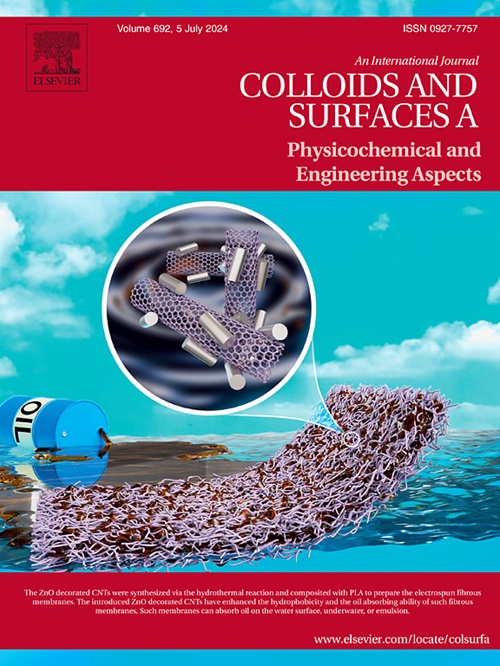Construction of malononitrile-functionalized conjugated microporous polymers as adsorbents for effective adsorption of Rhodamine B and density functional theory perspective
IF 4.9
2区 化学
Q2 CHEMISTRY, PHYSICAL
Colloids and Surfaces A: Physicochemical and Engineering Aspects
Pub Date : 2025-05-14
DOI:10.1016/j.colsurfa.2025.137214
引用次数: 0
Abstract
The escalating challenges of water pollution, driven by rapid industrialization and population growth, necessitate innovative solutions for removing hazardous contaminants such as synthetic dyes. Rhodamine B (RhB), a prevalent pollutant in wastewater, poses significant environmental and human health risks due to its toxicity and persistence. Conjugated microporous polymers (CMPs) have emerged as promising adsorbents for dye removal owing to their high surface area, tunable porosity, and versatile functionalization. In this study, we synthesized and characterized three CMPs [PTB-FO CMP, PTB-ANQ 2CN CMP, and PTB-ANQ 4CN CMP] differing in cyano group content and systematically evaluated their RhB adsorption performance under varying conditions and contact times. Among these, PTB-ANQ 4CN CMP exhibited the highest adsorption capacity across a broad pH range, demonstrating superior stability and enhanced dye-polymer interactions facilitated by cyano functionalities. Adsorption kinetics followed a pseudo-second-order model, indicative of a chemisorption-dominated process, while equilibrium adsorption data were best described by the Langmuir isotherm, suggesting monolayer adsorption. Density Functional Theory (DFT) calculations revealed that the calculated ΔN values for electron transfer from the dye to PTB-ANQ 4CN CMP, PTB-ANQ 2CN CMP, and PTB-FO CMP are 0.31, 0.26, and 0.05, respectively. These results indicate that PTB-ANQ 4CN CMP and PTB-ANQ 2CN CMP possess markedly stronger electronic interactions with the dye molecules compared to PTB-FO CMP. Based on the density functional theory (DFT) calculations, the calculated ΔN values for electron transfer from the dye to PTB-ANQ 4CN CMP, PTB-ANQ 2CN CMP, and PTB-FO CMP are 0.31, 0.26, and 0.05, respectively. Notably, PTB-ANQ 4CN CMP and PTB-ANQ 2CN CMP exhibit significantly stronger interactions with dye than PTB-FO CMP. These findings highlight the potential of cyano-functionalized CMPs as effective and sustainable materials for wastewater treatment, offering a viable strategy for mitigating synthetic dye pollution.
丙二腈功能化共轭微孔聚合物作为有效吸附罗丹明B的吸附剂的构建及密度泛函理论的展望
在快速工业化和人口增长的推动下,水污染的挑战不断升级,需要创新的解决方案来去除有害污染物,如合成染料。罗丹明B (RhB)是废水中的一种普遍污染物,由于其毒性和持久性,对环境和人类健康构成重大风险。共轭微孔聚合物(cmp)由于其高表面积、可调孔隙率和多功能功能化而成为有前途的染料去除吸附剂。在本研究中,我们合成并表征了三种氰基含量不同的CMP [PTB-FO CMP, PTB-ANQ 2CN CMP和PTB-ANQ 4CN CMP],并系统地评价了它们在不同条件和接触时间下对RhB的吸附性能。其中,PTB-ANQ 4CN CMP在较宽的pH范围内表现出最高的吸附能力,表现出优异的稳定性,并通过氰基官能团促进了染料与聚合物的相互作用。吸附动力学遵循伪二级模型,表明化学吸附为主,而平衡吸附数据最好用Langmuir等温线描述,表明单层吸附。密度泛函理论(DFT)计算表明,染料到PTB-ANQ 4CN CMP、PTB-ANQ 2CN CMP和PTB-FO CMP的电子转移ΔN值分别为0.31、0.26和0.05。这些结果表明,PTB-ANQ 4CN CMP和PTB-ANQ 2CN CMP与染料分子的电子相互作用明显强于PTB-FO CMP。根据密度泛函理论(DFT)计算,得到染料到PTB-ANQ 4CN CMP、PTB-ANQ 2CN CMP和PTB-FO CMP的电子转移ΔN值分别为0.31、0.26和0.05。值得注意的是,PTB-ANQ 4CN CMP和PTB-ANQ 2CN CMP与染料的相互作用明显强于PTB-FO CMP。这些发现突出了氰基功能化cmp作为有效和可持续的废水处理材料的潜力,为减轻合成染料污染提供了可行的策略。
本文章由计算机程序翻译,如有差异,请以英文原文为准。
求助全文
约1分钟内获得全文
求助全文
来源期刊
CiteScore
8.70
自引率
9.60%
发文量
2421
审稿时长
56 days
期刊介绍:
Colloids and Surfaces A: Physicochemical and Engineering Aspects is an international journal devoted to the science underlying applications of colloids and interfacial phenomena.
The journal aims at publishing high quality research papers featuring new materials or new insights into the role of colloid and interface science in (for example) food, energy, minerals processing, pharmaceuticals or the environment.

 求助内容:
求助内容: 应助结果提醒方式:
应助结果提醒方式:


